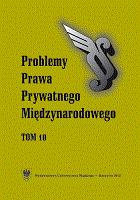Prawo właściwe, w razie braku wyboru prawa, dla umowy o kooperację przemysłową według konwencji rzymskiej i rozporządzenia Rzym I
Law applicable for industrial cooperation agreement in the absence of agreed choice according to the Rome Convention and Rome I Regulation
Author(s): Anna PacholskaSubject(s): Law, Constitution, Jurisprudence
Published by: Wydawnictwo Uniwersytetu Śląskiego
Keywords: private international law; law applicable; industrial cooperation; agreement
Summary/Abstract: The theme of articles is to determine the law applicable to the industrial cooperation agreement according to the Rome Convention and the Rome I Regulation in the absence of an agreed choice of law. This issue is of great importance in practice, because such agreements are often concluded in international trade. This article applies to industrial co‑operation agreements and the most common in practice, its subtypes, such as agreement on cooperative production on orders, contracts for the supply of components for a prior provision of co‑operative partner, product refining agreements, agreements on co‑production agreements, co‑operative company. In order to determine the applicable law, at the outset, made a brief characterization of each of these agreements. Was also studied the possibility of applying to each agreements the United Nations Convention on Contracts for the International Sale of Goods. Also analyzed, which contracts can be classified as a contract of sale by Regulation Rome I. For contracts mixed, connecting elements of typical and atypical contracts, to determine the applicable law, was used the collision absorption method or the concept of fragmentation of the contract in such way that its particular parties shall by governed by the other law. For each of the agreements was made an attempt to determine to separate the characteristic performance. If it was impossible to determine, used the closest connection principle.
Journal: Problemy Prawa Prywatnego Międzynarodowego
- Issue Year: 2012
- Issue No: 10
- Page Range: 137-158
- Page Count: 22
- Language: Polish

